What Is The Average Reliability Percentage Of Internet Service Providers
The 2020 National Internet Segment Reliability Enquiry
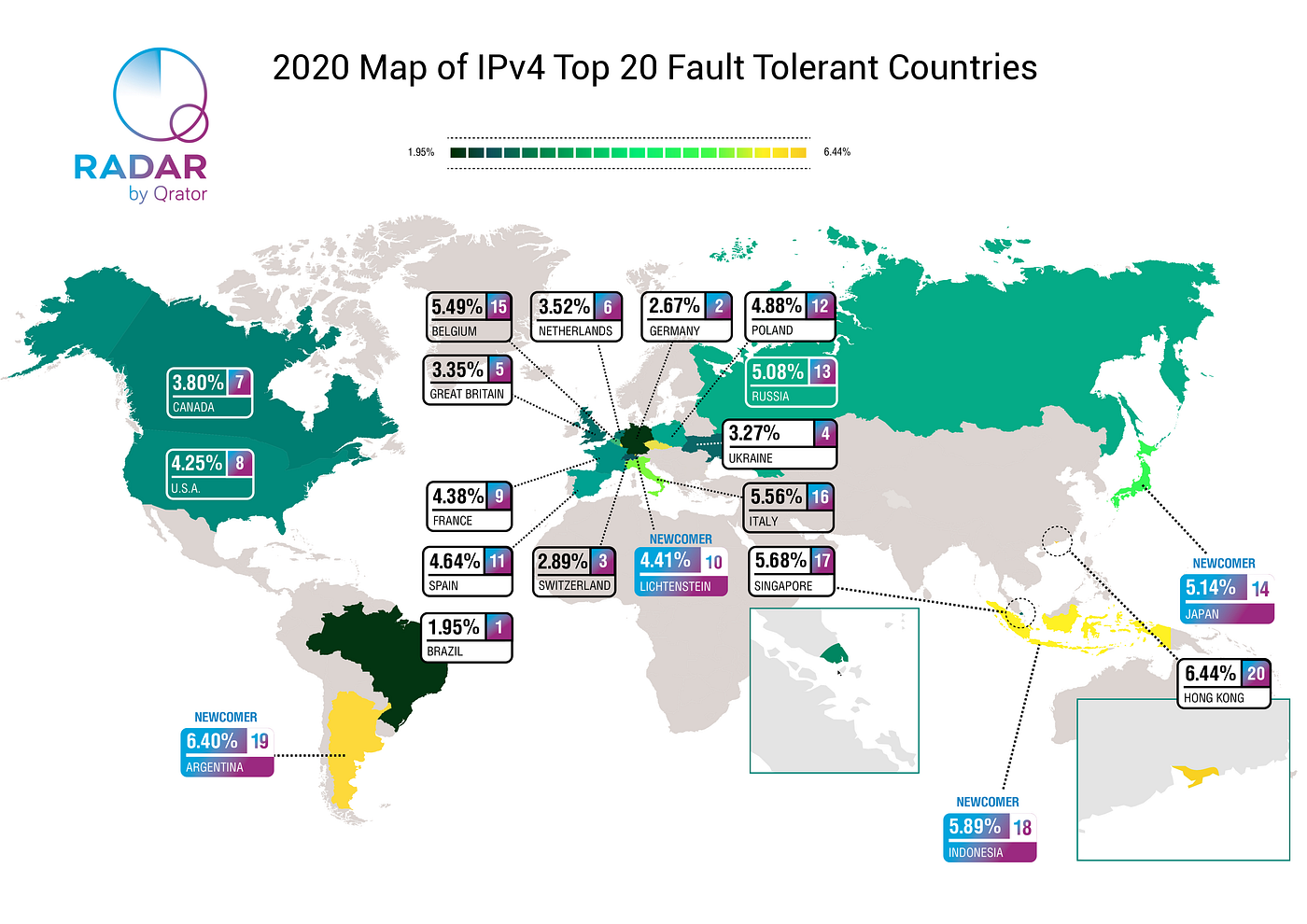
The National Cyberspace Segment Reliability Research explains how the outage of a single Democratic System might touch the connectivity of the impacted region with the residual of the world. Most of the time, the most critical AS in the region is the dominant ISP on the market, simply not e'er.
As the number of alternate routes betwixt AS's increases (and do not forget that the Net stands for "interconnected network" — and each network is an AS), so does the fault-tolerance and stability of the Cyberspace across the globe. Although some paths are from the get-go more than important than others, establishing as many alternating routes as possible is the only viable mode to ensure an adequately robust network.
The global connectivity of whatever given AS, regardless of whether information technology is an international giant or regional player, depends on the quantity and quality of its path to Tier-1 ISPs.
Ordinarily, Tier-1 implies an international company offer global IP transit service over connections with other Tier-one providers. Nonetheless, at that place is no guarantee that such connectivity volition be maintained all the fourth dimension. For many ISPs at all "tiers", losing connection to just i Tier-i peer would probable render them unreachable from some parts of the world.
The Methodology of Internet Reliability Measurement
Examining a case when an As experiences network degradation, we want to answer the following question: "How many AS's in the same region would lose connectivity with Tier-one operators and their global availability along with it?"
Throughout the years we model such a state of affairs because at the dawn of BGP and interdomain routing design its creators assumed that every non-transit Equally would have at least two upstream providers to guarantee fault tolerance in case i of them goes down.
Even so, the electric current reality is different; with less than half of all ISPs in the world having only one connection to an upstream transit provider. A range of anarchistic relationships among transit ISPs further reduces availability.
Have transit ISPs e'er failed? The reply is yes, and it happens with increasing frequency. The more appropriate question is — under what atmospheric condition would a particular Internet service provider feel service degradation so severe nosotros would phone call information technology an outage? If such bug seem unlikely, information technology may be worth considering Murphy's Law: "Anything that can go incorrect, will".
To model such a scenario, nosotros take applied the aforementioned model for the fourth year in a row. Although again, nosotros did not but echo previous calculations — the research is expanding over the years.
The post-obit steps were taken to rate Equally reliability:
- For every AS in the earth, we examine all alternate paths to Tier-one operators with the assistance of an AS relationship model, the cadre of Qrator.Radar;
- Using the Maxmind GeoIP database, nosotros matched countries to every IP address of every Every bit;
- For every Equally we calculated the share of its accost infinite that corresponds to the relevant region. ISP's were filtered out that reside at an Internet Commutation point in a region where they do not take a significant presence. The example we are using here is Hong Kong, where traffic is exchanged among hundreds of members of HKIX — yet the biggest Asian Internet Exchange, most of which have nothing presence in the local internet segment;
- Later isolating regional Donkey, nosotros analyzed the potential impact of one's outage on other Every bit's as well as their respective countries;
- In the end, for each country, nosotros identified the AS with the greatest/largest impact on other ASes in their region. Foreign Equally'south were not considered.
- We took that Every bit's impact value equally a reliability score for the country. And used that score to rate reliability of countries. The less score is — the better reliability is.
IPv4 Reliability
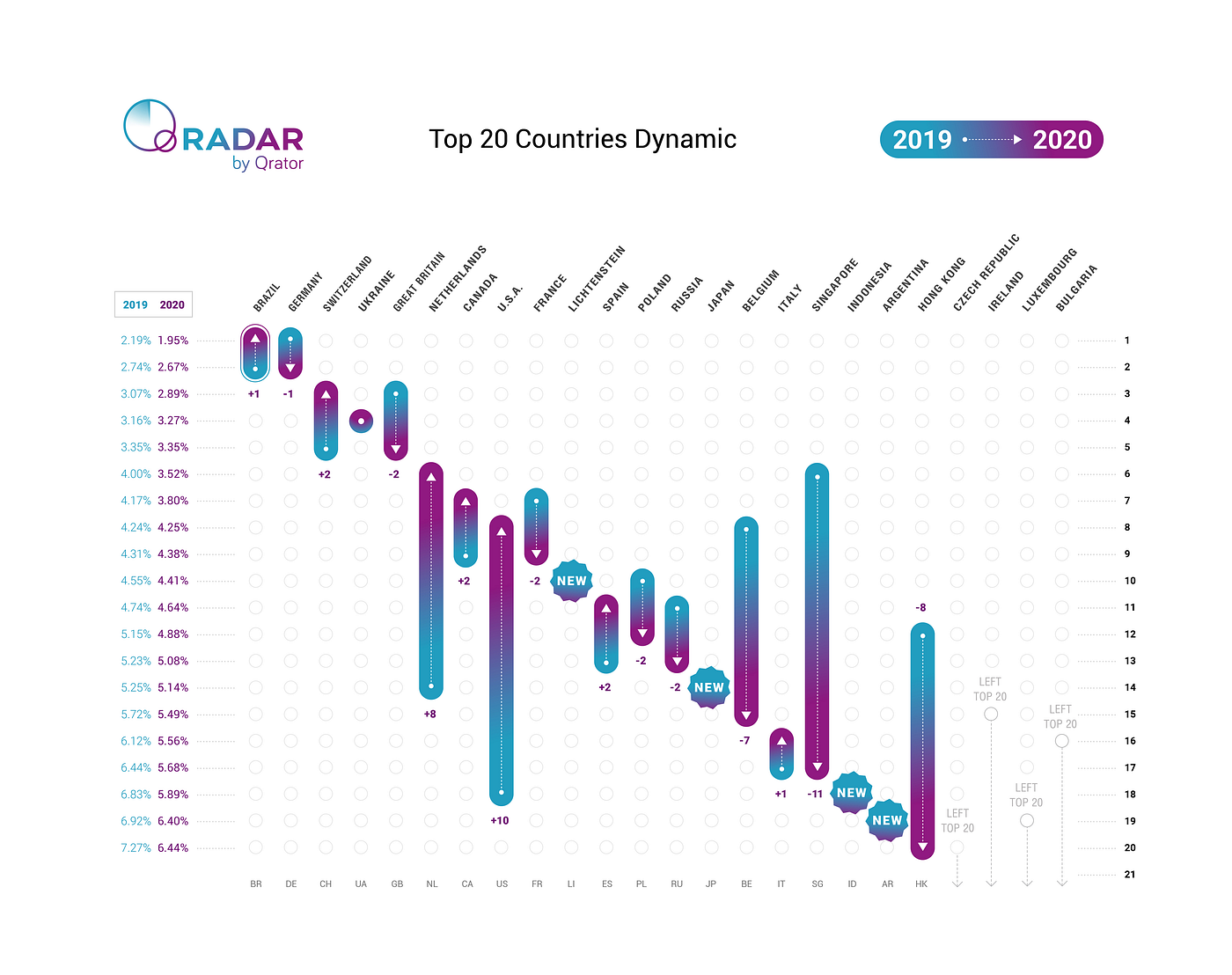
Long Story Short:
- The United States regained ten out of xi positions they lost in 2019, residing at position 8 in 2020;
- Four new countries entered the Top-twenty of reliability rating: Liechtenstein, Nippon, Republic of indonesia and Argentina.
- Four countries effectively left the Tiptop-xx: Ireland, Republic of bulgaria and Grand duchy of luxembourg and Czechia, which is residing at position 21 this year.
- Hong Kong dropped eight positions and closes the Top-20 in 2020;
- Singapore lost xi positions.
- A longtime leader of the rating — Frg — gave way to Brazil, the 2020 leader of reliability rating.
- Every twelvemonth exciting movements happen in the reliability rating, oftentimes corresponding to what is happening inside the respective regions.
Beginning things first — the overall trend in global reliability, counted every bit an average and medium. This time nosotros are looking at the 5 years of continuous research:
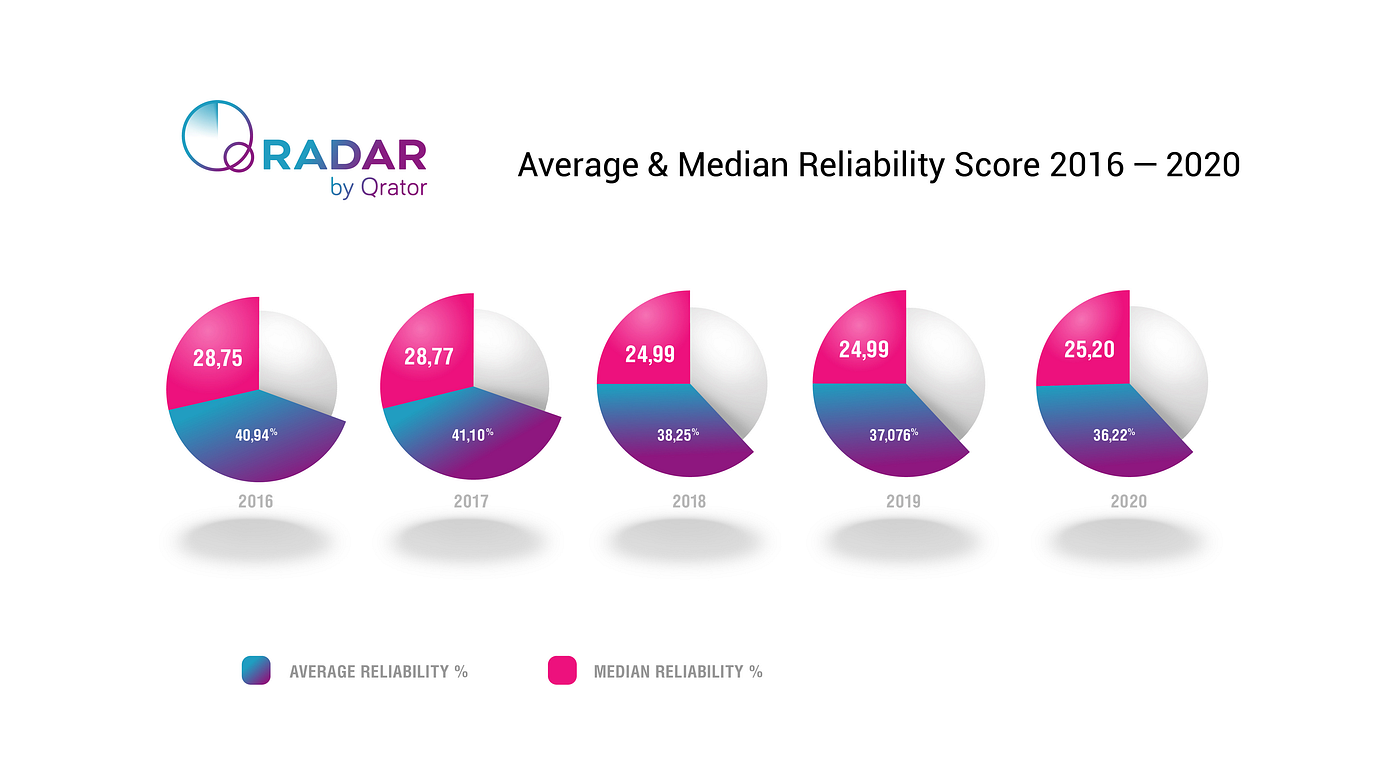
In 2020 the number of countries that successfully improved reliability score to under x%, indicating high fault tolerance, increased by 5 for the 2d year in a row, reaching a full of 40.
As you can also see, the average reliability score is improving over fourth dimension. However, the median stays at comparable levels since 2018 — the lower office of the rating does not improve speedily enough, compared to the upper half.
Nonetheless, the most significant fact remains — for the catamenia of our inquiry, both IPv4 and IPv6 evidence significant improvements in reliability. Furthermore, there is an inevitable point in the future, where the IPv6 version of the rating would go the main one.
IPv6 Reliability
In 2020 it seems that something has changed in the perception and adoption of the IPv6 protocol. Google obtains the most appropriate statistics we want to mention.

Equally of September 2020, almost 30% of Google users use the native IPv6 connection, which effectively translates into their ISPs supporting the v6 version of IP protocol.
Although the main issue with IPv6 still persists — that is the partial connectivity. Due to peering wars, not universal IPv6 adoption and other issues, the IPv6 still has the problem of limited network visibility. To meliorate understand this, take a look at the IPv6 reliability versus the partial connectivity rate.
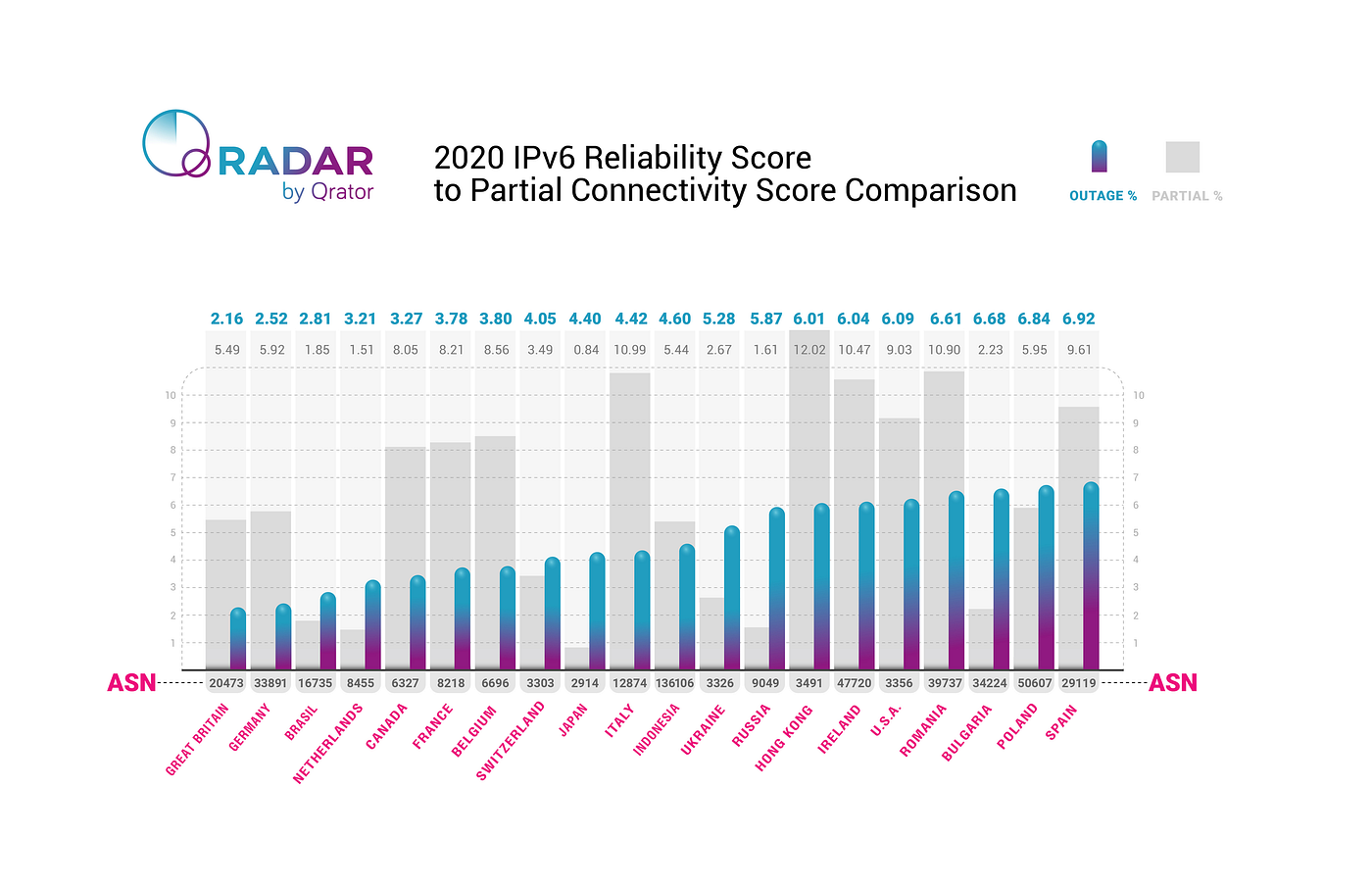
Information technology is evident from this IPv6 Top-20 Reliability to Partial Connectivity Comparison nautical chart that there are several countries where the partial connectivity in IPv6 exceeds x%: Italy, Hong Kong, Ireland, Romania.
Looking at the partial connectivity combined with "classic" reliability percentage, showing the share of unavailable in case of an outage resources, nosotros could state that in Hong Kong alone the IPv6 failure of AS3491 would result in xviii% of IPv6-connected resource rendered unavailable. xvi% in Ireland; almost the same in Italy and Romania. Those numbers are high even in United kingdom — seven.5%, Germany — viii%, Us — 15%.
The lowest value amongst IPv6 Top-20 belongs to Brazil — four.66%, Netherlands — 4.72% and Japan — v.24%.
It seems that in the twelvemonth 2020 the tides turned and the IPv6 reliability, even considering the partial connectivity, looks better than that of IPv4. Average IPv4 reliability score in 2020 is 36.22%, and for IPv6 the same metrics is as high as 28.71% — and as we measure the outage impact, the lower the metric is — the better. Yet, information technology is necessary to mention that the country adoption for IPv6 is twice equally low, as in the IPv4 instance — the newer version of the protocol still has to go a long fashion to the total adoption.
Broadband Internet and PTR records
"Does a state's leading ISP always influence regional reliability more than everyone else?" — this is the question we are trying to answer with the assistance of boosted information and investigation. We suggest that the most pregnant (by user base of operations or customer base of operations) ISP in a region is not necessarily the most critical for the region's network connectivity.
2 years ago, nosotros started to clarify the PTR records. Generally, PTR records are used for Reverse DNS lookup: using the IP-address to place the associated hostname or domain proper noun.
Since we already know the largest Equally's for every country in the world, we could count the PTR records within their network and determine their share of overall PTR records for the corresponding region. We counted only PTR records and did not calculate the ratio of IP-addresses without PTR records to IP-accost with them.
Then, nosotros are speaking strictly of IP-addresses with PTR records nowadays. The do of adding those is not universal; some providers do this and others exercise not.
In the PTR-based rating, we are looking at what role of PTR-enabled IP-addresses would get offline with an outage of each country's AS and the percentage that represents the relevant region.
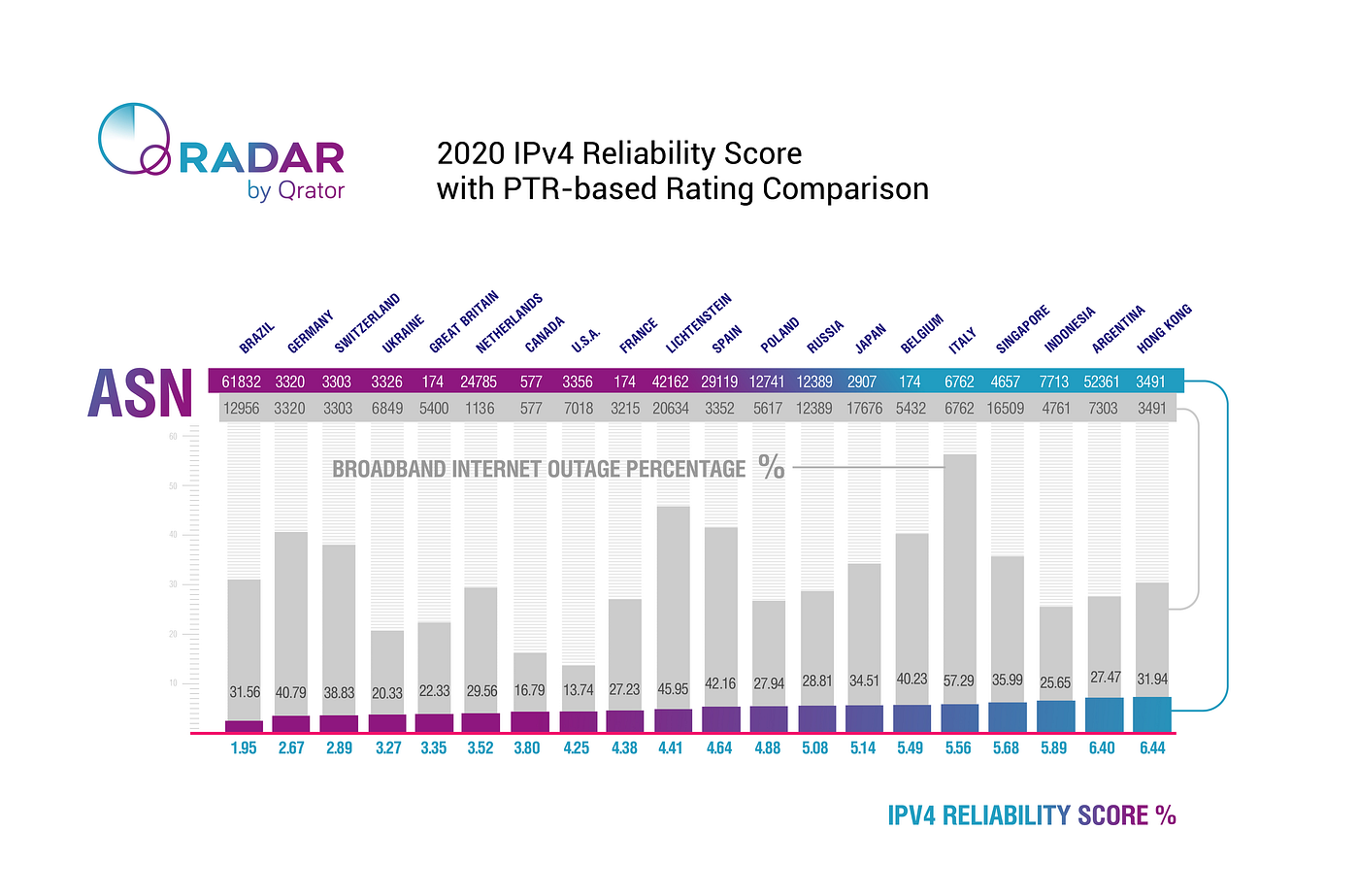
Such an approach that considers PTR-records yields very different results. In most cases, not only does the main regional As change, but the pct is entirely different. In all of the mostly reliable (from the global availability point of view) regions, the number of PTR-enabled IP-addresses that close down following an outage of one autonomous system is dozens of times college. That could mean that the leading national ISP always handles end-users at one signal or another.
Thus, nosotros should assume that this pct represents the part of the Internet service provider's user base of operations and customer base that would become offline (if switching to a second internet access provider were not possible) in the issue of an outage. From this perspective, countries appear to exist less reliable than they look from the transit point of view. We exit possible conclusions from this PTR-enabled rating to the reader.
ISPs With Only One Upstream (Stub networks) and Their Reliability
In vii out of the meridian 20 IPv4 Reliability Rating countries, we found a peculiar particular. Suppose we await for the largest provider for "stub networks", which are essentially networks with but one upstream provider. In that case, we will find another AS and Internet service provider, different from the one responsible for the current classical reliability metric for the corresponding national segment.

Here we highlighted the countries from both the tiptop of IPv4 Reliability Rating and IPv6 Reliability Rating for 2020.
Allow's talk about the almost visible differences betwixt the disquisitional Equally in terms of global transit versus the primary upstream choice in a specific region. It is interesting to discover that rarely a critical AS for stub networks would not exist the classical global critical AS simultaneously.
AS174 — Cogent — is special in IPv4. Cogent's changes are e'er interesting to investigate — every bit a Tier-i with a strong presence in Europe it has a tremendous responsibility, equally information technology is likewise a disquisitional AS for stub networks, likewise equally the global transit. In 2020 it is disquisitional Every bit for IPv6 stub networks in France and Kingdom of belgium, and in IPv4 Denoting is responsible for all the reliability metrics in Great United kingdom of great britain and northern ireland, France, Kingdom of belgium (from the IPv4 summit twenty), but also Ireland'southward and Vatican's global reliability metrics.
However, the Hong Kong case is somewhat outstanding. The classical critical Equally for the region's IPv4 connectivity is AS3491 — PCCW Global, a Tier-1 ISP. Withal, the stub networks' critical AS is an AS4515 — ERX-STAR — continued to both PCCW Global and Hong Kong 9. So for ERX-STAR, the situation is the following — if AS3491 somehow fails — it would still retain the regional connectivity through the IX, if, on the other hand, IX fails — the data would be still globally available through the Tier-ane network.
That is a detail example of how a significant and profound Cyberspace Substitution in i region could be a substitute for the second strong upstream provider. If there is a big IX nearby, past connecting to it and to but one classical transit Isp you could get almost the aforementioned regional reliability every bit by connecting to the two transit upstreams. Although, once again, Nine is not able to fully supplant the Tier-ane connexion in the global sense — It's an excellent example of regional versus global connectivity.
AS6939 — Hurricane Electric — is the stub networks' critical democratic systems in both Hong Kong and the U.S.A. for IPv6.
In the IPv4 it also changes — in the UsaA. the classical reliability arises from the position of AS3356, belonging to the CenturyLink ISP — simply the critical AS for stub networks in v4 is AT&T'south AS7018 — another Tier-i in the national segment of United states.
Details by Regions
One of the almost important questions to ask ourselves while conducting the 2020 enquiry was: "How was it possible for the U.Due south. segment to regain some reliability after the dramatical 11 positions drop last year and better the mistake tolerance of the national segment's Internet, without swapping the ISP in question — CenturyLink?"
Well, the first matter is that CenturyLink could have lost some of its market value, and this is probably the main reason why the numbers improved. Although it is hard to say for certain, we tend to think that CenturyLink's outages in the previous years, and the nearly recent one, probably motivated their customers to at least try to notice some additional transit capabilities, if non refusing the farther CenturyLink service at all.
Hong Kong'south position drop from 2019 to 2020 transition could exist connected to the irresolute situation within the region, although PCCW'southward market share about evidently fluctuated during this year.
We outlined the Singaporean modify in critical Equally for the region in the last yr'due south research and, looking at the electric current change; nosotros could country that AS4657 could be conquering the market place farther, consolidating as the primary ISP of the state — this would inevitably atomic number 82 to the drop of the reliability score.
As nosotros write this research from the Czech republic, we feel ourselves obligated to highlight the crucial detail most CZ'southward Internet segment. Information technology is probably the simply region nosotros know for sure that does non have a single Internet service provider business concern behind the critical autonomous system for the land. Instead, AS47232 — ISPAlliance — which is critical all effectually the metrics (classical global transit and stub networks), is a free and voluntary spousal relationship of smaller ISPs within the Czech republic. As the company writes on its "Aims and vision" page:
"Local telecommunication operators face up many difficulties on the market, which put them at a disadvantage vis-à-vis the "big brands" of multinational competition and those who do not play fair. Isp Alliance a.southward. nosotros set information technology upward to overcome these difficulties."
Information technology does aid to overcome the presence of much more significant players in the national segment! That is a good example of a grouping unification over a reasonable common goal, resulting in a good reliability score, equally even with the entering of the Top 20 by 4 new countries in 2020, Czech Commonwealth is at the position 21 with the reliability score of vi.five%. Moreover, such a small (compared to the other leaders' size) national segment taking 8 place in the quantity of IPv6 enabled ASes is merely a thing that should exist thanked for to anybody involved in edifice and maintaining computer networks.
Thanks for reading the Reliability Research! In case you have any questions, feel free to contact united states on radar@qrator.net.
What Is The Average Reliability Percentage Of Internet Service Providers,
Source: https://qratorlabs.medium.com/the-2020-national-internet-segment-reliability-research-cf7baf6b650a#:~:text=Average%20IPv4%20reliability%20score%20in,the%20metric%20is%20%E2%80%94%20the%20better.
Posted by: popehambsood.blogspot.com


0 Response to "What Is The Average Reliability Percentage Of Internet Service Providers"
Post a Comment